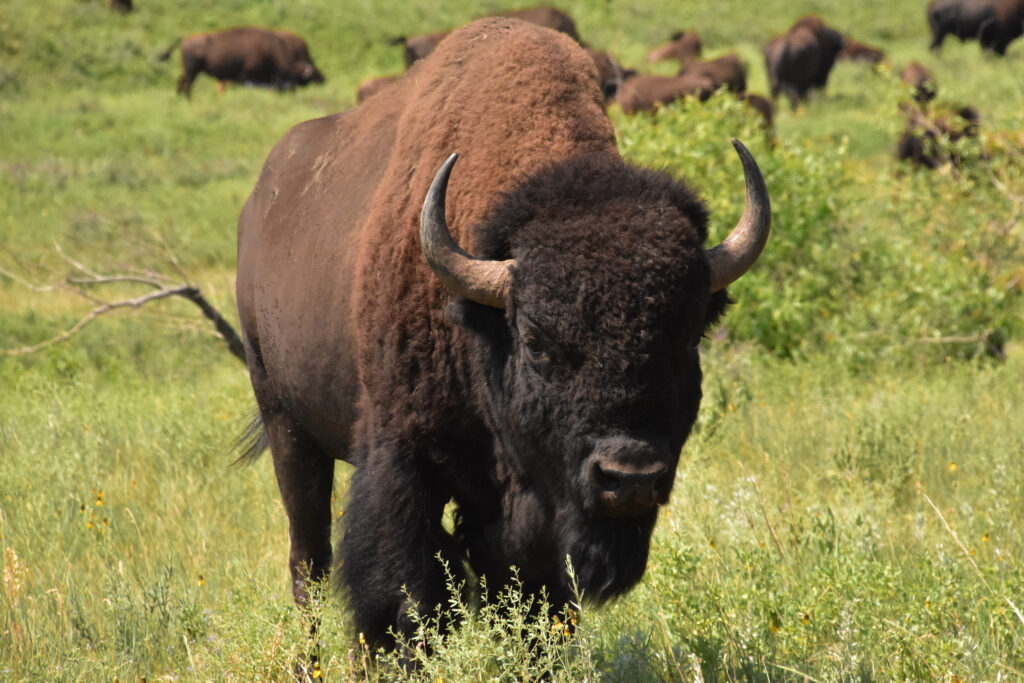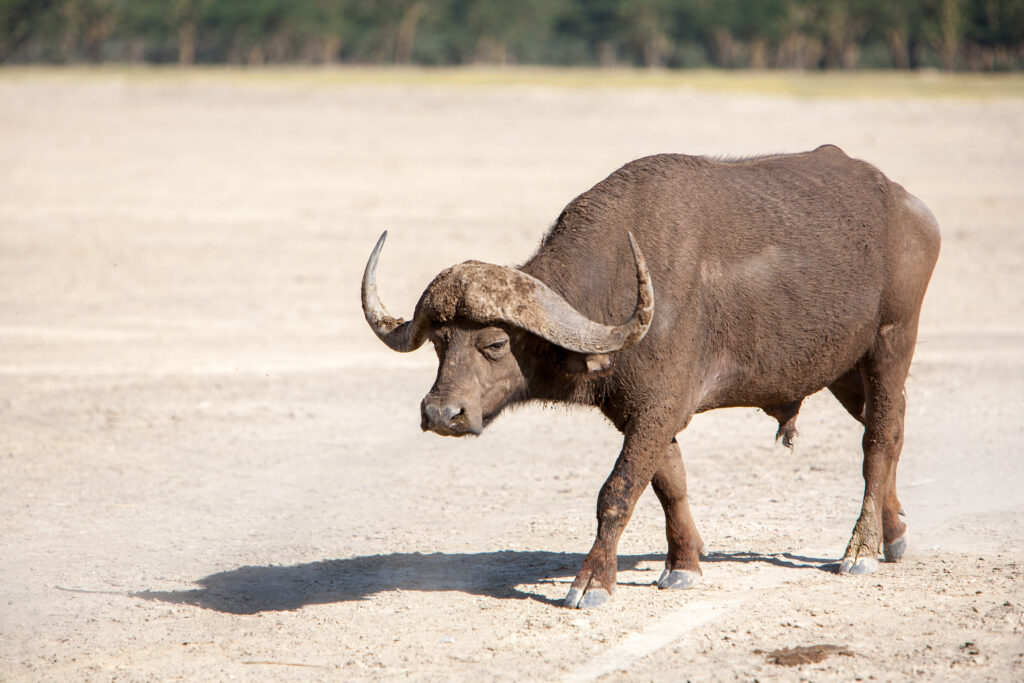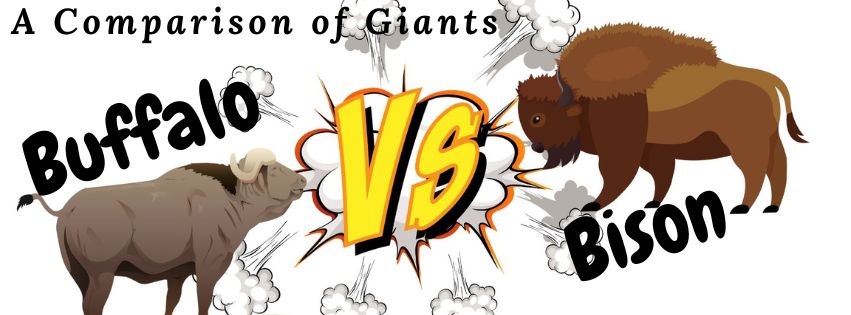When you hear “Bison vs Buffalo” you may picture the same mighty animals grazing in open fields. But are they really the same animal? We often imagine that they are similar creatures but bison and buffalo are distinct species with unique traits and fascinating histories.
From the vast prairies of North America to the swamps of Asia and the savannas of Africa, these animals have evolved in different environments. Due to their shared shape and appearance of similar horns, yet their origins, behaviors, and physical characteristics tell the story of variation across continents and ecosystems.
So, what makes a bison a bison and a buffalo a buffalo? Let us begin our journey to unravel the differences between these two giants of the animal kingdom.
The word “Buffalo” in North America is like a nickname. The proper term for the native species is “Bison“. Early European settlers confused bison with African or Asian buffalo, leading to the widespread but incorrect use of “buffalo” for bison.
Bison vs Buffalo – Let’s Explore About Them!
To understand the comparison of Bison vs Buffalo we need to look for their origin, physical characteristics, habitat and behavioral traits. Understanding these differences not only clears up common misconceptions but also sheds light on the diversity of nature.
Bison vs Buffalo – How are they classified.
Theses giants belong to the same family, Bovidae, they are classified into different genera and species. Bison include two different species: the American bison and the European bison, also known as the Wisent.
On the other hand buffalo has three species viz., African Buffalo, Domestic Water Buffalo, Wild Water Buffalo. These animals have been named on the basis of their occurrence, like Bison native to Northern America are named American Bison (Bison bison) and Europe are European Bison (Bison bonasus). Similarly Buffalo native to Africa are African Buffalo (Syncerus caffer) and Asia are Water Buffalo- Wild (Bubalus arnee) and Domestic (Bubalus arnee)
This classification highlights the evolutionary differences between these animals despite their shared ancestry within the family Bovidae.
For understanding about Family : Bovidae read more –
https://animaldiversity.org/accounts/Bovidae
Do these creatures have same Origin?
The lineages of bison and buffalo began to diverge about 2–3 million years ago, with bison adapting to the cooler climates of North America and Europe, while buffalo adapted to the warmer, tropical climates of Africa and Asia.
Scientists believe that the bison’s ancestors originated in Asia about 2.5 million years ago before migrating to Europe and North America via the Bering Land Bridge, which connected Asia to North America during the Ice Age.
Over time, bison adapted to the cold, open landscapes of North America and Europe, developing thick coats and powerful builds.
Buffalo and Bison share their ancestral lineage but their evolutionary path diverged much before bison’s evolution. African Buffalo’s early relatives evolved in Africa about 5-10 million years ago. On the contrary Water Buffalo evolved in Southeast Asia and are commonly domesticated.
Lets analyze how these animals differ in physically.
Bison are larger, more muscular, stocky, and have a prominent shoulder hump. They weigh 1,000 to 2,000 pounds and stand about 5 to 6 feet tall at the shoulder. These giants have large heads with short and curved horns. To adapt well to colder climates, these giants grow a thick, shaggy coat, especially around their shoulders. Their shorter tails bear tangled hair.


Buffalo are generally smaller and more slender, weighing 1,000 to 2,650 pounds and standing about 4.5 to 5.5 feet tall. They have smaller heads with large, thick horns protruding outwards and upwards, the African buffalo has a shield-like boss. They have short, smooth fur, suited to warm climates. Their tails are long and pointed.
Insight into the Habitat and Range of these Giants.
First, let’s understand habitat, which describes the specific environment where an animal lives, while range defines the broad geographical area where a species exists. When we compare the habitat of Bison vs Buffalo the most important is to understand where are they located.
We find Bisons in open grasslands, prairies, and forests. They are well suited in cold winters and mild summers. Historically, bison ranged mostly in North America and parts of Europe. Today, their range is more limited, found primarily in national parks and reserves in North America (such as Yellowstone) and protected areas in parts of Europe (eg, Poland, Belarus, and Russia). Their range has declined significantly due to overhunting and habitat loss.
Buffalo can be seen in savannas, grasslands, tropical forests, and wetlands. African buffalo thrive in areas with plenty of water and dense vegetation in sub-Saharan Africa, while water buffalo frequently inhabit flooded areas, rice paddies, and wetlands in Asia. The range of the African buffalo is in sub-Saharan Africa, from Kenya and Tanzania in the east to South Africa in the south. While, Water buffalo are native to South Asia, Southeast Asia and parts of China. People have introduced them to other parts of the world, especially for agricultural purposes, expanding their range beyond their native habitat.
A healthy nature helps in survival of any species but there are some myths about nature which is leading to its destruction please read more –
Analyzing their behavioral traits and Habitat.
These both animals have quiet distinct characteristic in terms of physical appearance and habitat which quiet affect their overall behavior and living style.
Learn more about different habitat –
https://kids.nationalgeographic.com/nature/habitats
Bison –
Bisons live in seasonal herds i.e., form large herds in summer which categorized as per their genders like male bachelor smaller groups and female with calves forming a different group. But during winters herds may merge but overall group size is small. Bison are quiet aggressive thus their herds show hierarchical behavior where dominance is established by head butting. They become violent during mating seasons or during protecting younger ones with high speed and horns. Despite being of considerable size they are agile and quick runners escaping themselves from predators. Bisons graze on grass in open plains in summer while in winters they migrate and dig through snow to reach grass. They avoid humans and get agitated if approached. Conservation efforts have brought them into closer proximity with people in protected areas like Yellowstone National Park.
African Buffalo and Water Buffalo –
African buffalo form large herds that can number in the hundreds or thousands, providing protection from predators. These herds are tightly knit, with strong bonds between members. Older males often leave the herd and live alone or in small bachelor groups. Water buffalos are typically domesticated and if live in small groups when in wild. African buffalo exhibit unpredictable and aggressive behavior, especially when injured or cornered. They are one of the most dangerous animals in Africa and have a reputation for being fearless against predators such as lions.
In contrast, water buffalo are generally dutiful in a domestic environment but can defend themselves in the wild. Buffalo are grazers and move around oftenly, eating grasses as well as shrubs and aquatic plants.
Water buffalo often graze in wet, swampy areas and prefer to eat submerged vegetation. People often domesticate them, as well they play an important role in agriculture and transportation in Asia. These animals are commonly gentle with humans but can be wild in untamed environments.
Read more about such animals –
https://en.wikipedia.org/wiki/Buffalo
Not all animals are peacefully in nature, some organisms are slowly disappearing from our lands read more –
Bison vs Buffalo: A Final Comparison
Bison vs Buffalo comparison of these giants helped us understand how names can be confusing. I hope you enjoyed reading about these animals and this article must have provided a better understanding towards them. When we compare Bison vs Buffalo, we observe predominantly that – Bison use their muscular build and dense, shaggy fur to withstand harsh, cold environments, while buffalo rely on their sleek coats and impressive horns to thrive in the warm, tropical landscapes of Africa and Asia.
These differences not only set them apart but also highlight the incredible adaptability of the animals around them.

Leave a Reply